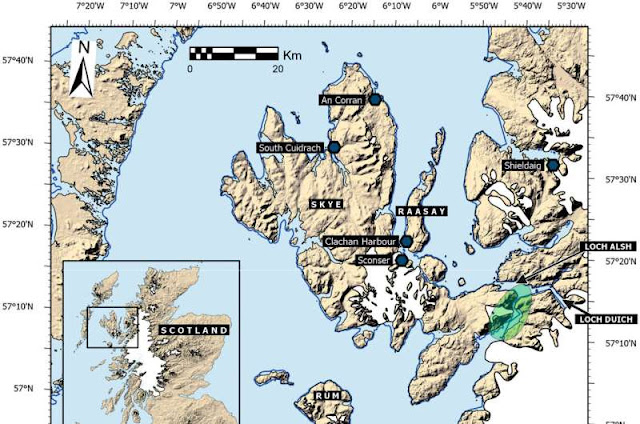Rewriting His-story (again) in Scotland
"Archaeological evidence for a Late Upper Paleolithic human presence in Scotland remained scarce until the past two decades."
Discovery of ancient culture on remote Scottish isle rewrites the range of early settlers
Map of Isle of Skye showing the Loch Lomond Stadial (LLS) ice extent (in white) during the Younger Dryas period (from Bickerdike et al., 2018) and the 12 000 a bp shoreline estimated using glacial isostatic adjustment modeling by Clark et al. (2022) (in blue), which highlights the exposed lowland terrestrial routes and the site of a potential land bridge during the lowest tides that likely existed at this time due to the relative sea level being lower than present. Credit: Journal of Quaternary Science (2025). DOI: 10.1002/jqs.3718
Researchers led by the University of Glasgow in Scotland have identified a Late Upper Paleolithic site in the far north of the Isle of Skye, marking the most northerly evidence of Ahrensburgian culture in Britain. (tribe names we need to keep track of...)
Originating in northern Europe toward the end of the Upper Paleolithic, Ahrensburgian culture is characterized by distinctive stone tools, including tanged points and blades, associated with reindeer hunters during the later part of the Younger Dryas and into the Early Holocene.
Ahrensburgian artifacts were discovered at South Cuidrach, indicating their presence during the later part of the Younger Dryas. Additional evidence on the isle includes stone circular alignments likely built at a time of lower sea levels, suggesting human activity potentially dating to the Early Holocene.
Archaeological evidence for a Late Upper Paleolithic human presence in Scotland remained scarce until the past two decades. Past assumptions held that populations could not have survived the climatic extremes of the Younger Dryas, a period of abrupt cooling that occurred between approximately 12,900 and 11,700 years ago, characterized by significant glacier expansion across the British Isles.
Lithic artifacts discovered on the west coast of the Scottish mainland were previously regarded as isolated and short-lived, insufficient to suggest sustained settlement. Then came the tanged points and blade technology found on the Isle of Skye, further challenging past assumptions.
The Isle of Skye sits just off the western coast of Scotland, separated from the mainland by narrow straits, including the Kylerhea Narrows, a crossing point that may have facilitated prehistoric movement between the island and the mainland during periods of lower sea levels. Skye's rugged terrain, mountainous landscapes, and glacially carved coastal lines provide critical context for assessing a newly discovered settlement site that no one expected to find.
In the study, "At the far end of everything: A likely Ahrensburgian presence in the far north of the Isle of Skye, Scotland," published in the Journal of Quaternary Science, researchers conducted a field study to assess climatic, environmental, and sea-level contexts surrounding the newly discovered Late Upper Paleolithic site at South Cuidrach on the Isle of Skye.
Fieldwork occurred at two primary locations. South Cuidrach in northern Skye and Sconser in central Skye. Excavations at South Cuidrach covered a 30 m2 area, where researchers documented a lithic scatter comprising tanged points, blade technology, and burins, indicating Ahrensburgian cultural characteristics. And at Sconser, a series of ~ 20 intertidal stone circular alignments measuring 3 to 5 meters in diameter were identified, suggesting potential anthropogenic activity dating to the Early Holocene.
Researchers employed systematic test pitting to establish artifact distribution patterns and stratigraphic context at South Cuidrach. Aerial drone surveys provided elevation data and orthomosaic mapping, facilitating the documentation of site morphology and spatial layout.
Radiocarbon dating of associated Mesolithic deposits established a temporal framework, though no direct dates were obtained for the Ahrensburgian artifacts.
Excavations at South Cuidrach revealed a lithic assemblage comprising 196 artifacts, including tanged points, blades, chisels (burins), and scrapers. Most of the lithic material was manufactured from locally sourced baked mudstone, indicating access to a consistent raw material source.
Several fragments of tanged points exhibit characteristics associated with Ahrensburgian culture, suggesting a Late Upper Paleolithic presence in the region. Additional blade fragments and burins, while not diagnostically Ahrensburgian, align with broader Late Upper Paleolithic typologies identified across northern Europe.
At Sconser, researchers identified up to twenty circular stone alignments within the intertidal zone. Measuring between 3 and 5 meters in diameter, each alignment consists of boulders embedded within marine sediment. Visible only during extreme low tides, these features lack diagnostic artifacts or direct radiocarbon dates.
Elevation surveys and bathymetric analysis place the alignments within a range of 1.83–4.14 meters below present mean sea level, suggesting construction during a period of lower sea levels.
Comparative analysis of similar stone features in Norway provides a potential Early Holocene (post Younger Dryas) timeframe. No definitive cultural affiliation is associated with the alignments, though there are few other candidates.
Intertidal stone structures at Sconser raise intriguing questions about settlement patterns and perhaps size during the Early Holocene. If these are associated with a settlement, there may be more, further out, from the time of the glacial maximum, now hidden beneath the waves along the coastal landscapes of Skye.
While the purpose is unknown, they could have been used as fish traps or tidal hunting structures, potentially linking them to similar structures found in Scandinavia around the same time and other areas of Scotland in later eras.
Evidence from South Cuidrach and Sconser challenges assumptions about human presence in western Scotland during the Younger Dryas.
Identification of Ahrensburgian-type artifacts on Skye suggests a population may have adapted to extreme conditions. A people who originated in the mainland of northwest Europe, crossed Doggerland into Britain and eventually felt at home at the far end of everything.
SOURCE: https://phys.org/news/2025-05-discovery-ancient-culture-remote-scottish.html





Comments
Post a Comment
leave a message please